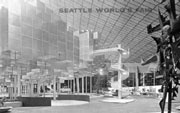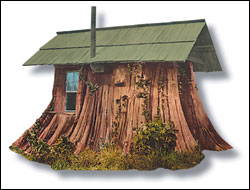I REMEMBER the future well. It happened 40 years ago this month in a place where Camelot and the Cold War met on the well-groomed avenues of what we now call Seattle Center. It was a world in which clean-cut middlebrows could imagine a New Jerusalem dotted with Space Needles, heliports, and monorails, where we could live in push-button homes and frolic without fear of nuclear war because the universals of reason and science had triumphed.
The 1962 Century 21 Exposition—better known as the Seattle World’s Fair—was a comparatively small fair by international standards, but in the grand tradition begun with London’s Great Exhibition of 1851, it was a state-of-the-art technological showcase designed to tease us about the possibilities of the future. It was also the high-water mark of New Frontier sense and sensibility, a place where the Elvis ’50s transitioned into the John Glenn ’60s. The U.S. government invested heavily in a science-themed pavilion with the goal to show the Soviets that their Sputnik could eat our moondust. American know-how would dominate the clean slate of the next century.
Some expositions have virtually vanished from their host’s cityscape or have left only a tourist attraction or two. New York City hosted two World’s Fairs in Flushing Meadow and still only managed to turn an ash dump into a park. But Century 21 remains very much alive in Seattle, both in terms of the infrastructure that remains and the agendas we’re pursuing to this day.
For the downtown business leadership of 1962, the World’s Fair was a chance to show off how Seattle had grown in the half-century since its first World’s Fair, the Alaska-Yukon-Pacific Exposition of 1909. It was also a chance to get federal dollars for urban renewal and to bundle a host of civic projects, including the completion of I-5 through downtown and the construction of the 520 bridge. The contrast between the old and the new was there for everyone to see. Look at old photos of pre-skyscraper Seattle with its sparkling new fairgrounds and you see two cities. One is a provincial port in the far Northwest corner of the Lower 48 that once puffed out its flanneled chest at being “Gateway to Alaska.” The other is a vibrant campus of architectural strangeness: Towers, arches, needles, cones, and cubes—little that resembles a mid-20th-century structure you could put a name to. This is the new Seattle, launch pad to the space age.
Today, the fair is still admired for its Jetsons fantasies and modern design, remembered as a place where a transparent elevator (“Bubbleator” in Century 21- speak) was piloted by young men in Star Trek-style uniforms, who intoned: “Please step to the rear of the sphere!” The Bubbleator was dismantled in the mid-1980s, but the Space Needle remains, a landmark that crops up in film or on TV as the retro cool headquarters of Dr. Evil or the postapocalyptic perch for pouty Max in Fox’s Dark Angel.
The fair also left us with venues that draw crowds for theater, opera, dance, concerts, and professional sports; these, in turn, have helped boost the overall quality of life Seattleites love to chirp about. Odd to remember that at one time, the Food Circus (now Center House) was about the only place in town a family could find exotic fare. During Century 21 it actually featured—Look, Ma!–a French restaurant.
While Seattle Center never revitalized or integrated with downtown, the two “cities” have cross-fertilized: the symphony has migrated to the core and flourishes amid the Niketowns and Cheesecake Factories. Seattle Center continues to attract eccentric bits of expo eclecticism, notably the blobular, LSD-inspired EMP. Despite a certain coldness, the old fairgrounds have become the place to ring in the New Year or hold a vigil. The flowered mandala of the International Fountain after Sept. 11 made it clear just what Seattle Center is: the center of our civic outpourings.
THE FAIR’S LEGACY also still surfaces in the city’s endeavors. The monorail is the obvious example: We’re still enthralled by the fair’s promise that one day we would all be shuttled around painlessly on these sleek machines. It’s fortunate that few remember Ford’s concept car for the fair, the “Seattle-ite XXI,” which was to be powered by its own nuclear reactor.
And the fair echoes in the new downtown library. Study the design of Dutch deconstructionist Rem Koolhaas and you’ll see a structure of glass and metallic grids encasing a high-tech storehouse that offers a plug-in for every laptop. One of its central features is a spiral staircase lined with books. Now take a look at old photos of the fair’s “World of Tomorrow” exhibit inside the Coliseum (now KeyArena): It’s an interior of aluminum cubes and grids featuring a spiral staircase. It housed the Library of the Future, where a giant Univac computer answered your questions.
Some critics of the new building have huffed that it would fit better in Bellevue, with that city’s glass and graph-paper high-rises. But our World’s Fair forefathers would likely have seen the Koolhaas design as an antidote to Seattle’s endemic fustiness, right at home in the city they dreamed we’d build.
But the Bellevue reference is germane. The vision of Century 21 was suburban by design. According to University of Washington history professor John Findlay, who has studied postwar development in the West from Sun City to Century 21, the expo’s target was “prosperous, well-educated people—the kind of crowd Disneyland attracted.” Boeing families, you might say. Organizers fenced in the exposition and hired seasoned Disney veterans to make sure it ran smoothly and with a smile. Mall planners and market researchers had their hands in the design. The fair represented a city that was attractive, gated, and rather isolated. A city, Findlay says, that “you need landing gear to get to.”
It was also a city prepared to meet the world, ready to export its concept of the future on landing gear of its own. This was done quite literally via Boeing jets. Those planes aren’t merely technological exports, but cultural ones. Fly to any major airport on the planet and you’ll experience the generic sanitized mall culture that originated in the minds of Boeing’s designers. Who do you think invented the stewardess?
Suburban modernism, so integral to Century 21, is the staple of our trade today, more lucrative than apples ever were. Think Microsoft, whose dominant software is the equivalent of the tract home: useful for most, pleasing to no one. Think Starbucks offering morning medication in every time zone. Think Costco, Nordstrom, Amazon.com. Think Kenny G.
No wonder the Space Needle shows up on Al Qaeda computers. Perhaps as much as the World Trade Center—designed by Minoru Yamasaki, the Seattle native who also designed the Pacific Science Center—the Space Needle symbolizes the future that America promised and Seattle is attempting to deliver. It’s the beacon of a century that’s starting to unfold—or unravel.
SEATTLE PREDICTS
EARLIER THIS YEAR, workers uncovered a time capsule that was buried in the Opera House at the dedication of the Seattle Center, a few weeks before the opening of the World’s Fair in April 1962. The capsule was supposed to be opened after 50 years, in 2012, but the makers failed to mark the capsule or leave instructions, so it was opened a decade early. Inside were letters to the future, written by civic leaders and city bureaucrats to their 21st century counterparts. Many include observations and predictions about life in this century. Seattle Weekly offers this peek at some of the predictions, along with our own take on how reality is keeping pace.
What They Imagined: “In the year 2012, Seattle will either be a mighty metropolis of more than 1,000,000 residents—or it will have become a charred, deserted relic of a fearful age of nuclear warfare.” David Levine, Seattle City Council president
Progress Report: The population of Pugetopolis is about 3.3 million souls; Seattle proper has 560,000. The Kingdome was built, then imploded; the Space Needle may be a target for an Al Qaeda suitcase nuke.
What They Imagined: “We confidently predict that tuberculosis, which was the number one cause of death in 1912, will be sufficiently rare in 2012 to create a real stir when death occurs. . . . Other chronic diseases, cancer, heart disease, alcoholism and emotional illness will have followed the eradication route.” S.P. Lehman, Dept. of Public Health
Progress Report: In 2001, Seattle Mariners shortstop Carlos Guillen contracted TB; the Centers for Disease Control reports the top 15 leading causes of death in the U.S. include heart disease (1) cancer (2) stroke (3) and chronic liver disease and cirrhosis (12); an estimated 5.4 percent of American adults suffer from a serious mental illness.
What They Imagined: “I imagine that now you have a symphony orchestra on the Moon! Alas . . . I will never know if Boulez or Stockhausen have become staples of the symphonic repertoire up there.” Milton Katims, maestro, Seattle Symphony.
Progress Report: No lunar philharmonic, but a member of ‘N Sync is planning a trip to the International Space Station.
What They Imagined: “We hope that you in 2012 will not be too bored with your two hour workday during which you check the automatic machines to see that they are operating properly. The current progress of automation leads us to believe that the poor old human being will have been nearly relegated to the sidelines by 2012.” City Employees’ Retirement System Board of Administration
Progress Report: Many city workers are now facing a zero-hour work day.
What They Imagined: ” . . . [W]e note with interest the involvement of intoxicating liquor in cases involving some type of physical violence. When considered in the light of what appears to be a rapid rise in the number of teenagers using intoxicants today, we have become apprehensive as to the standard of conduct of our future generations unless this propensity is checked.” Seattle Municipal Court of Seattle, Dept. #1
Progress Report: Mardi Gras.
What They Imagined: “Today we are talking about Monorail, helicopters, parking garages. Will these advance concepts be as outdated 50 years hence as were the railroad terminals and traffic patterns of 50 years ago? Probably they will.” Paul W. Seibert, Central Association of Seattle
Progress Report: Monorail? What’s a monorail?
Knute Berger







